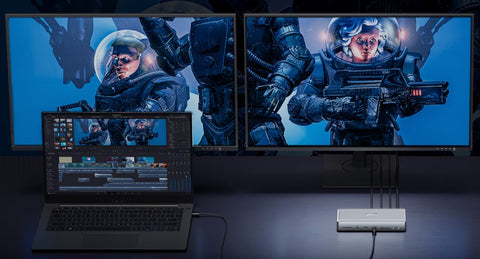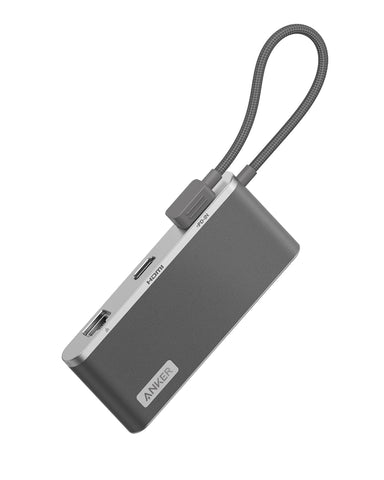
Master the Basics: How to Connect USB to MacBook Pro Easily
As a vault of versatility and functionality, your MacBook Pro isn't just a sleek device, but it's a digital enabler that can be expanded in countless ways using external USB devices. However, to unlock this potential, a fundamental understanding of the USB ports that your MacBook Pro supports is key, alongside knowledge of how to connect USB to MacBook Pro. This article will tackle a variety of USB ports in every MacBook Pro, providing a step-by-step process for establishing a seamless connection between your MacBook Pro and those USB devices, and delving into an array of external USB devices that could potentially amplify your MacBook Pro's capabilities. Prepare to unlock new possibilities as you seamlessly integrate your peripherals and MacBook Pro.

What Kind of USB Ports Does a Macbook Support?
The types of USB ports that a MacBook supports can vary depending on the model and year of the MacBook. Here's a general overview of the types of USB ports that have been featured on various MacBook models:
Thunderbolt 4
MacBooks that support Thunderbolt 4 ports provide users with a versatile and powerful connection option, which are essentially USB-C ports with additional capabilities. Thunderbolt 4 is the latest iteration of this technology, offering high data transfer speeds of up to 40Gbps and the ability to drive two 4K displays or one 8K display. Moreover, it can deliver up to 100W of power to charge your MacBook and support data transfer for various peripherals using USB-C cables, making it a robust all-in-one connection solution.
Thunderbolt 3
Thunderbolt 3 enables users to utilize a range of advanced features offered by this technology. Thunderbolt 3 shares many similarities with Thunderbolt 4, boasting a high data transfer rate of up to 40Gbps, support for multiple display configurations (two 4K or one 5K), and delivering up to 100W of power to charge the MacBook. Though slightly older than Thunderbolt 4, Thunderbolt 3 is still a potent and flexible connectivity choice.
USB 3.0
MacBooks that support USB 3.0 ports provide reliable connectivity to a wide array of peripherals and accessories. USB 3.0, also known as USB 3.1 Gen 1 or USB 3.2 Gen 1x1, is a standard that delivers data transfer rates of up to 5Gbps, which is 10 times faster than its predecessor USB 2.0. While it does not offer the same advanced capabilities as Thunderbolt ports, USB 3.0 ports are compatible with a vast selection of devices and have become ubiquitous in modern technology.
USB-A
USB-A ports on MacBooks allow users to connect their devices and peripherals using the traditional, rectangular USB-A connectors. USB-A is a prevalent and widely-used standard, which works with various USB versions from USB 1.1 up to USB 3.2; however, the actual performance and capabilities of USB-A ports will depend on the underlying USB standard supported by the MacBook. Although newer MacBooks may not come with built-in USB-A ports, users can still connect USB-A devices using adapters or docks available on the market.
How to Connect a USB Device to Your Macbook Pro?
Connecting a USB device to a MacBook Pro is a straightforward process. The method you use will depend on the type of USB port available on your MacBook Pro. Here are the steps for connecting a USB device:
Identify the USB Port
Identifying the USB port on your MacBook Pro is the first step in connecting a USB device to it. The type of USB port on your MacBook Pro could be a USB-C, which is distinguished by its small, reversible design. If your MacBook Pro is older, you might have a USB-A port instead, easily recognized by its rectangle shape. The USB port's location varies, but you can typically find them on either side of your MacBook Pro.
Select the Correct Cable
After identifying the USB port, ensuring you have the correct cable is of utmost importance. If your device uses a traditional USB (USB-A), and your MacBook Pro has a USB-C or Thunderbolt 3 port, you'll need a USB-C to USB adapter. If both the MacBook and your device support USB-C, then a USB-C to USB-C cable will suffice. Always double-check the cable compatibility with the MacBook Pro to prevent any potential damage or risk of malfunction.
Interact with the Device
Upon selecting the correct cable and connecting your device, your MacBook Pro should automatically recognize it. To interact with the device, click on the Finder icon, located in the Dock at the bottom of your screen. A sidebar will appear on the left; under the 'Devices' section, select the name of your USB device. You can now manipulate files, transfer data, or perform any other actions as necessary. If your device is not recognized, confirm the device is powered on and try reinserting the USB cable.
Disconnect the USB Cable
The final step is to safely disconnect the USB device from your MacBook Pro. This involves ejecting the device correctly before physically disconnecting the cable to prevent potential loss of data. You can do this by tapping/clicking the 'Eject' icon next to the device in the Finder's sidebar, or simply right-clicking the device icon and selecting 'Eject'. After your MacBook Pro confirms that the device can be safely removed, you can unplug your USB device.
What Kind of External USB Device Can You Connect to Your Macbook Pro
Several types of external USB devices can be connected to your MacBook Pro. These devices commonly include:
External Hard Drives: You can expand your storage capacity or back up data with external hard drives.
Thumb Drives (USB Drives): Thumb drives offer portable storage solutions useful for transferring files between devices. They can be connected to your MacBook Pro via Thunderbolt, USB, or USB-C.
Flash Memory Cards (Memory Card Readers): Memory card readers provide portability and an easy way to transfer files from memory cards, such as SD cards, to your computer. They are also connected through Thunderbolt, USB, or USB-C.
Peripherals: Other devices like mice, keyboards, and printers can be connected to your MacBook Pro using USB or USB-C cables, or wirelessly via Bluetooth.
USB Hubs and Adapters: Hubs and adapters (e.g., USB-C or Thunderbolt) enable you to connect multiple USB devices to your MacBook Pro, especially if your device has limited USB ports.
Looking for the perfect accessories for your MacBook Pro? Check out these recommendations:
Anker 777 Thunderbolt Docking Station (Apex, 12-in-1, Thunderbolt 4)
The Anker 777 Thunderbolt Docking Station (Apex, 12-in-1, Thunderbolt 4), specifically built for non-M1 MacBooks, facilitates powerful charging, fast data transfer, and expanded display options through its multi-port structure. With Thunderbolt 4, HDMI, and USB-C ports, it offers compatibility across numerous gadgets and achieves impressive video resolutions for an enhanced display experience.

Anker 655 USB-C Hub (8-in-1)
The Anker 655 USB-C Hub (8-in-1) is a unique fusion of style and functionality. This hub offers extensive connectivity including a 100W USB-C power port, 2 USB-A 3.2 Gen 2 data ports, a 4K HDMI port, an Ethernet port, and microSD/SD card slots for quick data transfers at 10 Gbps. An AUX port and the capability to mirror or extend displays up to 4K@60Hz enrich its utility.

Conclusion
In conclusion, MacBook Pro laptops offer a range of USB port options, including Thunderbolt 4, Thunderbolt 3, USB 3.0, and USB-A. To further expand connectivity, docking stations and USB hubs serve as invaluable tools, allowing users to link multiple devices and peripherals seamlessly to their MacBook Pro. Whether it's a comprehensive docking station for a complete workstation setup or a compact USB hub for on-the-go convenience, these accessories enhance the MacBook Pro's versatility by accommodating an array of external USB devices, thereby enhancing productivity and providing an enriched user experience!
FAQ
Here are some commonly asked queries on how to connect USB to MacBook Pro.
Why Is My USB Not Connecting to My Macbook Pro?
If your USB is not connecting to your MacBook Pro, begin by verifying the power status and the integrity of cable connections for the USB device. Ensure the device is powered on and cables are securely linked. If your MacBook Pro has multiple USB ports, attempt connecting the device using a different port. If the issue persists, seeking assistance from the manufacturer is recommended for further guidance.
Can I Connect Multiple USB Devices at Once?
Yes, it is indeed possible to connect multiple USB devices at once to your computer. This can be achieved ultimately by using a USB hub, which provides additional USB ports. However, it's crucial to note that the data transfer rate may reduce if too many devices are connected and operating simultaneously due to the shared bandwidth of the USB hub.
Can I Charge My USB Device Through My MacBook Pro's USB Ports?
Yes, you can use your MacBook Pro's USB ports to provide power and charge your USB devices. The MacBook Pro can provide power over a USB connection even when it isn't connected to electrical power, although charging devices in this way can deplete the MacBook's battery more quickly. When the MacBook Pro is connected to power, it is an effective way to charge your USB devices.















